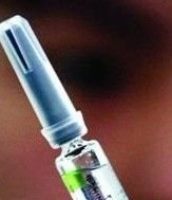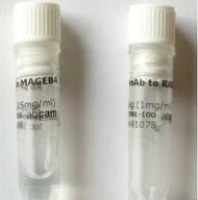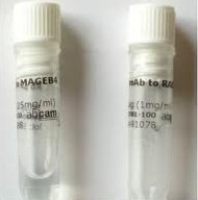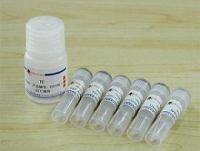
产品详情
文献和实验
相关推荐
供应商 :上海西格
库存 :58
靶点 :详见说明书
级别 :详见说明书
目录编号 :详见说明书
克隆性 :多克隆
抗原来源 :Rabbit
保质期 :详见说明书
抗体英文名 :Anti-Prion protein PrP
抗体名 :朊/感染性蛋白抗体
标记物 :详见说明书
宿主 :详见说明书
适应物种 :详见说明书
免疫原 :KLH conjugated synthetic peptide derived from human Major prion protein
亚型 :IgG
形态 :详见说明书
应用范围 :WB=1:100-500 ELISA=1:500-1000 IP=1:20-100 IHC-P=1:100-500 IHC-F=1:100-500 ICC=1:100-500 IF=1:100-500
浓度 :1mg/1ml
保存条件 :详见说明书
规格 :0.1ml/100μg 0.2ml/200μg
实验原理 :(1)特异性结合抗原:抗体本身不能直接溶解或杀伤带有特异抗原的靶细胞,通常需要补体或吞噬细胞等共同发挥效应以清除病原微生物或导致病理损伤。然而,抗体可通过与病毒或毒素的特异性结合,直接发挥中和病毒的作用。
(2)活补体:IgM、IgG1、IgG2和IgG3可通过经典途径激活补体,凝聚的IgA、IgG4和IgE可通过替代途径激活补体。
(3)结合细胞:不同类别的免疫球蛋白,可结合不同种的细胞,参与免疫应答。
(4)可通过胎盘及粘膜:免疫球蛋白G(IgG)能通过胎盘进入胎儿血流中,使胎儿形成自然被动
免疫。免疫球蛋白A(IgA)可通过消化道及呼吸道粘膜,是粘膜局部抗感染免疫的主要因素。
(5)具有抗原性:抗体分子是一种蛋白质,也具有刺机体产生免疫应答的性能。不同的免疫球蛋白分子,各具有不同的抗原性。
(6)抗体对理化因子的抵抗力与一般球蛋白相同:不耐热,60~70℃即被破坏。各种酶及能使蛋白质凝固变性的物质,均能破坏抗体的作用。抗体可被中性盐类沉淀。在上常可用硫酸铵或硫酸钠从免疫血清中沉淀出含有抗体的球蛋白,再经透析法将其纯化。

| 产品名称 | 朊/感染性蛋白抗体 |
| 英文名称 | Anti-Prion protein PrP抗体 |
| 货号 | XGK0534 |
中文名称 朊/感染性蛋白抗体
别 名 AltPrP; ASCR; atal familial insomnia; CD230; CD230 antigen; CJD; Creutzfeld Jakob disease; Gerstmann-Strausler-Scheinker syndrome; GSS; KURU; Major prion protein; MGC26679; p27 30; PRIO_HUMAN; Prion protein; Prion related protein; PRIP; Prni; Prnp; PrP; PrP27 30; PrP27-30; PrP33 35C; PrP33-35C; PrPC; PrPSc; Sinc.
浓 度 1mg/1ml
规 格 0.2ml/200μg
抗体来源 Rabbit
克隆类型 polyclonal
交叉反应 Human, Mouse, Rat, Cow, Horse, Sheep
产品类型 一抗
研究领域 肿瘤 免疫学 神经生物学 干细胞 细胞凋亡 细胞表面分子 Alzheimer's
蛋白分子量 predicted molecular weight: 23kDa
性 状 Lyophilized or Liquid
免 疫 原 KLH conjugated synthetic peptide derived from human Major prion protein
亚 型 IgG
纯化方法 affinity purified by Protein A
储 存 液 Preservative: 15mM Sodium Azide, Constituents: 1% BSA, 0.01M PBS, pH 7.4
产品应用 WB=1:100-500 ELISA=1:500-1000 IP=1:20-100 IHC-P=1:100-500 IHC-F=1:100-500 ICC=1:100-500 IF=1:100-500
产品介绍 The protein encoded by this gene is a membrane glycosylphosphatidylinositol-anchored glycoprotein that tends to aggregate into rod-like structures. The encoded protein contains a highly unstable region of five tandem octapeptide repeats. This gene is found on chromosome 20, approximately 20 kbp upstream of a gene which encodes a biochemically and structurally similar protein to the one encoded by this gene. Mutations in the repeat region as well as elsewhere in this gene have been associated with Creutzfeldt-Jakob disease, fatal familial insomnia, Gerstmann-Straussler disease, Huntington disease-like 1, and kuru. An overlapping open reading frame has been found for this gene that encodes a smaller, structurally unrelated protein, AltPrp. Alternative splicing results in multiple transcript variants. [provided by RefSeq, Oct 2012].
Function : May play a role in neuronal development and synaptic plasticity. May be required for neuronal myelin sheath maintenance. May play a role in iron uptake and iron homeostasis. Soluble oligomers are toxic to cultured neuroblastoma cells and induce apoptosis (in vitro). Association with GPC1 (via its heparin sulfate chains) targets PRNP to lipid rafts. Also provides Cu(2+) or ZN(2+) for the ascorbate-mediated GPC1 deaminase degradation of its heparan sulfate side chains.
Subunit : Monomer and homodimer. Has a tendency to aggregate into amyloid fibrils containing a cross-beta spine, formed by a steric zipper of superposed beta-strands. Soluble oligomers may represent an intermediate stage on the path to fibril formation. Copper binding may promote oligomerization. Interacts with GRB2, APP, ERI3/PRNPIP and SYN1. Mislocalized cytosolically exposed PrP interacts with MGRN1; this interaction alters MGRN1 subcellular location and causes lysosomal enlargement. Interacts with KIAA1191.
Subcellular Location : Cell membrane; Lipid-anchor, GPI-anchor. Golgi apparatus. Note=Targeted to lipid rafts via association with the heparan sulfate chains of GPC1. Colocates, in the presence of CU(2+), to vesicles in para- and perinuclear regions, where both proteins undergo internalization. Heparin displaces PRNP from lipid rafts and promotes endocytosis.
Post-translational modifications : The glycosylation pattern (the amount of mono-, di- and non-glycosylated forms or glycoforms) seems to differ in normal and CJD prion.
Isoform 2 is sumoylated with SUMO1.
DISEASE : Note=PrP is found in high quantity in the brain of humans and animals infected with neurodegenerative diseases known as transmissible spongiform encephalopathies or prion diseases, like: Creutzfeldt-Jakob disease (CJD), fatal familial insomnia (FFI), Gerstmann-Straussler disease (GSD), Huntington disease-like type 1 (HDL1) and kuru in humans; scrapie in sheep and goat; bovine spongiform encephalopathy (BSE) in cattle; transmissible mink encephalopathy (TME); chronic wasting disease (CWD) of mule deer and elk; feline spongiform encephalopathy (FSE) in cats and exotic ungulate encephalopathy (EUE) in nyala and greater kudu. The prion diseases illustrate three manifestations of CNS degeneration: (1) infectious (2) sporadic and (3) dominantly inherited forms. TME, CWD, BSE, FSE, EUE are all thought to occur after consumption of prion-infected foodstuffs.
Defects in PRNP are the cause of Creutzfeldt-Jakob disease (CJD) [MIM:123400]. CJD occurs primarily as a sporadic disorder (1 per million), while 10-15% are familial. Accidental transmission of CJD to humans appears to be iatrogenic (contaminated human growth hormone (HGH), corneal transplantation, electroencephalographic electrode implantation, etc.). Epidemiologic studies have failed to implicate the ingestion of infected annimal meat in the pathogenesis of CJD in human. The triad of microscopic features that characterize the prion diseases consists of (1) spongiform degeneration of neurons, (2) severe astrocytic gliosis that often appears to be out of proportion to the degree of nerve cell loss, and (3) amyloid plaque formation. CJD is characterized by progressive dementia and myoclonic seizures, affecting adults in mid-life. Some patients present sleep disorders, abnormalities of high cortical function, cerebellar and corticospinal disturbances. The disease ends in death after a 3-12 months illness.
Defects in PRNP are the cause of fatal familial insomnia (FFI) [MIM:600072]. FFI is an autosomal dominant disorder and is characterized by neuronal degeneration limited to selected thalamic nuclei and progressive insomnia.
Defects in PRNP are the cause of Gerstmann-Straussler disease (GSD) [MIM:137440]. GSD is a heterogeneous disorder and was defined as a spinocerebellar ataxia with dementia and plaquelike deposits. GSD incidence is less than 2 per 100 million live births.
Defects in PRNP are the cause of Huntington disease-like type 1 (HDL1) [MIM:603218]. HDL1 is an autosomal dominant, early onset neurodegenerative disorder with prominent psychiatric features.
Defects in PRNP are the cause of kuru (KURU) [MIM:245300]. Kuru is transmitted during ritualistic cannibalism, among natives of the New Guinea highlands. Patients exhibit various movement disorders like cerebellar abnormalities, rigidity of the limbs, and clonus. Emotional lability is present, and dementia is conspicuously absent. Death usually occurs from 3 to 12 month after onset.
Defects in PRNP are the cause of spongiform encephalopathy with neuropsychiatric features (SENF) [MIM:606688]; an autosomal dominant presenile dementia with a rapidly progressive and protracted clinical course. The dementia was characterized clinically by frontotemporal features, including early personality changes. Some patients had memory loss, several showed aggressiveness, hyperorality and verbal stereotypy, others had parkinsonian symptoms.
Similarity : Belongs to the prion family.
Database links : UniProtKB/Swiss-Prot: P04156.1 human
UniProtKB/Swiss-Prot:P10279 Bovine
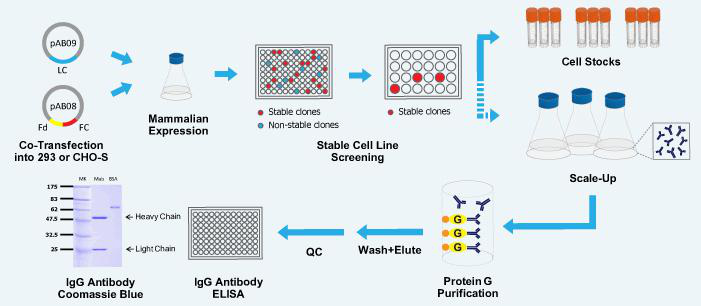
抗体制备过程:
1.材料与试剂
a.提取的动物 Ig
b.弗氏完全佐剂和弗氏不完全佐剂
c.青霉素和链霉素
d.实验动物 兔
e.其它材料及试剂
2、选择实验活体。
3、进行动物免疫实验。
4、试取血样进行测试,查看免疫效果。
5、如果免疫成功,杀死实验活体,采集全部血清。
6、纯化出抗体。
7、鉴定抗体。胎牛血清(无菌采制)
我司提供以下技术外包服务:
1. Anti-Prion protein PrP抗体分子生物学:质粒抽提、PCR、Q-PCR、RT-PCR、分子生物学:基因合成、引物合成、基因测序、载体构建等
2.蛋白工程:原核、哺乳动物蛋白表达系统等
3.病毒包装:腺病毒、慢病毒等
4.抗体工程:磁珠分选、病理染色、WB、ELISA、IP、IF、IHC、FACS、Confocal等等
5.细胞工程:细胞表型分析(凋亡、增殖、周期、迁移、侵袭、修复、克隆形成)、细胞培养、细胞膜制备、稳定细胞株构建、细胞RNAi技术等等。
Anti-VAMP-1/FITC 荧光素标记囊泡相关膜蛋白1抗体IgGMulti-class antibodies规格: 0.2ml
CD14(cluster of differentiation antigen 14) CD14/内毒素受体抗原Multi-class antibodies规格: 0.5mg
巨噬细胞炎性蛋白3α抗体 Anti-CCL20/MIP3αMacrophage inflammatory ptotein 3 alpha 0.1ml
SNAP23 英文名称: 突触相关蛋白23抗体 0.2ml
Exportin 5 英文名称: 核输出蛋白5抗体 0.2ml
Rhesus antibody Rh Phospho-HER4 (Tyr984) 0酸化HER4抗体 规格 0.1ml
CD14(cluster of differentiation antigen 14) CD14/内毒素受体抗原Multi-class antibodies规格: 0.5mg
Anti-PMSA/FOLH1/FITC 荧光素标记前列腺特异膜抗原抗体IgGMulti-class antibodies规格: 0.2ml
Goat Anti-rat IgG Whole serum 羊抗大鼠IgG抗血清Multi-class antibodies规格: 1ml
丝氨酸蛋白酶/线粒体丝氨酸蛋白酶抗体 anti-HtrA2/Omi 0.2ml
Mouse Anti-rat IgG 小鼠抗大鼠IgG 1mg
FEM1A 英文名称: 前列腺素E受体4相关蛋白抗体 0.2ml
Rhesus antibody Rh phospho-Rb(Ser249) 视网膜母细胞瘤相关蛋白1抗体 规格 0.1ml
Goat Anti-rat IgG Whole serum 羊抗大鼠IgG抗血清Multi-class antibodies规格: 1ml
DISC1(disrupted in schizophrenia1)(CT) DISC1 C端抗原Multi-class antibodies规格: 0.5mg
Anti-CCR7/CD197 细胞表面趋化因子受体7抗体Multi-class antibodies规格: 0.1ml
Rhesus antibody Rh Paxillin 桩蛋白Paxillin抗体 规格 0.1ml
FCGR2B Kit Human 人 CD32b / FCGR2B ELISA配对抗体 ELISA
Transaldolase 1 英文名称: 转醛醇酶抗体 0.2ml
CSP 英文名称: 环子孢子蛋白(约氏疟原虫)抗体 1ml
Anti-CCR7/CD197 细胞表面趋化因子受体7抗体Multi-class antibodies规格: 0.1ml
人E选择素(E-Selectin/CD62E)ELISA 试剂盒 96T/48T 试剂盒 组装/原装
兔血管性血友病因子/瑞斯托霉素辅因子(VWF)免疫试剂盒 Rabbit von Willebrand Factor,VWF ELISA Kit
羟赖酸(Hyl)ELISA试剂盒 ,英文名: Hyl ELISA Kit
rabbitFibrinogenDegradationProduct,FDPELISA试剂盒兔子血纤蛋白原降解产物(FDP)ELISA试剂盒规格:96T/48T
HumanAi-myocardialaibody,AMAELISA试剂盒人抗心肌抗体(AMA)ELISA试剂盒规格:96T/48T
Humancaspaseactivateddeoxyribonuclease,CADELISAKit人胱天蛋白酶激活的脱氧核糖核酸酶(CAD)ELISA试剂盒规格:96T/48T
Anti-Prion protein PrP抗体人对基苯(PABA)ELISA 试剂盒 96T/48T 试剂盒 组装/原装
小鼠KI-67抗原(MKI67)免疫试剂盒 Mouse aigen KI-67,MKI67 ELISA kit
胃动素(MTL)ELISA试剂盒 ,英文名: MTL ELISA Kit
Mouseneuophilgelatinase-associatedlipocalin,NGALELISA试剂盒小鼠中性粒细胞明胶酶相关脂质运载蛋白(NGAL)ELISA试剂盒规格:96T/48T
ELISAKitPLAUR/uPAR兔尿激酶型纤溶酶原激活物受体规格:48T/96T
guineapigfollicle-stimulatinghormone,FSHELISAKit豚鼠促卵泡素(FSH)ELISA试剂盒规格:96T/48T
抗体的鉴定:
1)抗体的效价鉴定:鉴定效价的方法很多,包括有试管凝集反应,琼脂扩散试验,酶联免疫吸附试验等。常用的抗原所制备的抗体一般都有约成的鉴定效价的方法,以资比较。如制备抗抗体的效价,一般就采用琼脂扩散试验来鉴定。
2)抗体的特异性鉴定:抗体的特异性是指与相应抗原或近似抗原物质的识别能力。抗体的特异性高,它的识别能力就强。衡量特异性通常以交叉反应率来表示。交叉反应率可用竞争抑制试验测定。以不同浓度抗原和近似抗原分别做竞争抑制曲线,计算各自的结合率,求出各自在IC50时的浓度,并按公式计算交叉反应率。
3)真核翻译起始因子2C2抗体的亲和力:是指抗体和抗原结合的牢固程度。亲和力的高低是由抗原分子的大小,抗体分子的结合位点与抗原决定簇之间立体构型的合适度决定的。有助于维持抗原抗体复合物稳定的分子间力有氢键,疏水键,侧链相反电荷基因的库仑力,范德华力和空间斥力。亲和力常以亲和常数K表示,K的单位是L/mol。

上海西格生物科技有限公司
实名认证
钻石会员
入驻年限:5年

